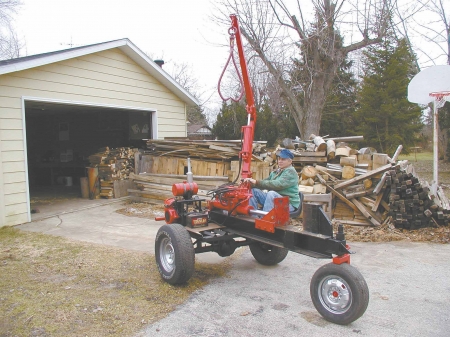 When Mark Froehlich fires up his log splitter, no tree in the area is
safe. His 3-wheel splitter can handle about anything he can lift onto it.
When Mark Froehlich fires up his log splitter, no tree in the area is
safe. His 3-wheel splitter can handle about anything he can lift onto it.
Froehlich's boom can handle up to 1,000 lbs. "I've split pieces 4 ft.
across," says Froehlich. "The ram has a 48-in. stroke and is built to
the specifications of a 42-ton splitter."
Froehlich built the splitter from an old 3-wheeled pruning rig with a cherry
picker basket on a telescoping boom. The engine was good, as were the hydraulic
valves and cylinders. He modified the cherry picker basket arm to serve as a
pickup boom for handling large logs.
"All the controls were in the basket, so I moved them to an operator's
station that I built over the engine," says Froehlich. "I replaced
all the hoses, but everything else, including the hydraulic motors on the three
wheels, were fine."
He braced the boom and doubled the thickness of the 4 by 4-in. upright. "I
figured if the cherry picker basket could support a 200-lb. man, this thing
should be able to handle a 1,000-lb. chunk of wood."
The original arm that held the basket is hinged to the vertical post. A 24-in.
cylinder raises and lowers the arm.
"I mounted a 22 1/2-ft. long, 18-in. high, tempered structural beam across
the top of the chassis," says Froehlich. "The ram mounts on it, and
the 12-in. wedge is welded to it."
Froehlich says he was warned the structural beam wouldn't hold up so he
reinforced it, lining the top where the ram travels with used grader blades. A
second plate reinforces the wedge.
"I used the original valves on the cherry picker to control all the
hydraulics," says Froehlich.
Froelich's neighbor, Richard Freid, liked the splitter but decided he didn't
need one quite as big. He built a down-sized version with a 9-ft. long, 8 by
8-in. H-beam that serves as both the splitter base and the main frame of the
splitter. At the rear, the H-beam extends past the axle to support a Kohler 8
hp engine and 3,000-lb. hydraulic pump.
The pump supplies power to the hydraulic motor connected to the rear axle
pinion gear and the three boom cylinders.
"I can disconnect the pinion on the rear, and remove the entire front
wheel assembly to pull it like a trailer," explains Freed.
To steer the splitter when under its own power, Freed uses the 4-in. splitter
ram itself. He installed a linkage between the ram and a bell crank (used for
changing direction on a pivot point) on the front wheel assembly.
"When I extend the ram, it steers to the right and then to the left when I
retract the ram," says Freed. "When it's at the halfway point, it
steers straight."
He installed a safety chain on the ram, as he's learned he can overpower the
linkage if he isn't careful. When the ram is needed for splitting, Freed simply
removes the linkage and stores it inside the webbing of the H-beam.
Freed hung an operator's seat on the side opposite the boom, mounting a bank of
control valves in front. He laid it out like the controls on a backhoe. The one
exception is the valve for the hydraulic motor that runs the rear drive. It's
mounted under the seat and moves the drive into reverse or forward.
1-800-834-9665
Giant Splitter Handles Huge Logs
FARM SHOW Magazine » Giant Splitter Handles Huge Logs
Giant Splitter Handles Huge Logs
